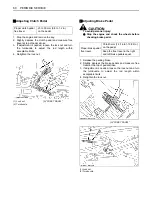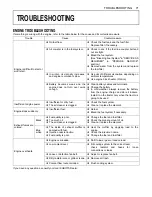
67
PERIODIC SERVICE
EVERY 2 YEARS
B
Flushing Cooling System and Changing
Coolant
To avoid personal injury:
A
Do not remove radiator cap while coolant is
hot. When cool, slowly rotate cap to the first
stop and allow sufficient time for excess
pressure to escape before removing the cap
completely.
1. Stop the engine, remove the key and let it cool down.
2. To drain the coolant, open the radiator drain cock, and
remove radiator cap. The radiator cap must be
removed to completely drain the coolant.
3. After all coolant is drained, close the drain cock.
4. Fill with clean soft water and cooling system cleaner.
5. Follow directions of the cleaner instruction.
6. After flushing, fill with clean soft water and anti-freeze
until the coolant level is just below the radiator cap.
Install the radiator cap securely.
7. Fill with coolant up to the "FULL" mark of recovery
tank.
8. Start and operate the engine for few minutes.
9. Stop the engine, remove the key and let cool.
10.Check coolant level of recovery tank and add coolant
if necessary.
11.Properly dispose of used coolant.
A
Do not start engine without coolant.
A
Use clean, fresh soft water and anti-freeze to fill the
radiator and recovery tank.
A
When mixing the anti-freeze with water, the anti-freeze
mixing ratio is 50 %.
A
Securely tighten radiator cap. If the cap is loose or
improperly fitted, water may leak out and the engine
could overheat.
B
Anti-Freeze
To avoid personal injury:
A
When using antifreeze, put on some protection
such as rubber gloves (Antifreeze contains
poison.).
A
If should drink antifreeze, throw up at once and
take medical attention.
A
When antifreeze comes in contact with the skin
or clothing, wash it off immediately.
A
Do not mix different types of Antifreeze.
The mixture can produce chemical reaction
causing harmful substances.
A
Antifreeze is extremely flammable and
explosive under certain conditions. Keep fire
and children away from antifreeze.
A
When draining fluids from the engine, place
some container underneath the engine body.
A
Do not pour waste onto the grounds, down a
drain, or into any water source.
A
Also, observe the relevant environmental
protection regulations when disposing of
antifreeze.
If it freezes, coolant can damage the cylinders and
radiator. If the ambient temperature falls below 0
(32
) or before a long-term storage, let out cooling water
completely, or mix fresh water with long-life coolant and fill
the radiator and recovery tank with the mixture.
1. Long-life coolant (hereafter LLC) comes in several
types. Use ethylene glycol (EG) type for this engine.
2. Before employing LLC-mixed cooling water, fill the
radiator with fresh water and empty it again.
Repeat this procedure 2 or 3 times to clean up the
inside.
3. Mixing the LLC
Put the LLC in cooling water in the percentage (%) for
a target temperature. When mixing, stir it up well, and
then fill into the radiator.
4. The procedure for the mixing of water and antifreeze
differs according to the make of the antifreeze and the
ambient temperature. Refer to SAE J1034 standard,
more specifically also to SAE J814c.
A
When the antifreeze is mixed with water, the
antifreeze mixing ratio must be less than 50%.
Coolant capacity
(with recovery tank)
3.9 L (4.1 U.S.gals.)
(1) Radiator cap
(2) Recovery tank
(3) Drain cock
(A) "FULL"
(B) "LOW"
Vol %
Anti-freeze
Freezing Point
Boiling Point*
40
50
-24
-37
-12
-34
106
108
222
226
Содержание B2320
Страница 1: ......
Страница 14: ...SAFE OPERATION 6 7 DANGER WARNING AND CAUTION LABELS ...
Страница 15: ...7 SAFE OPERATION ...




















